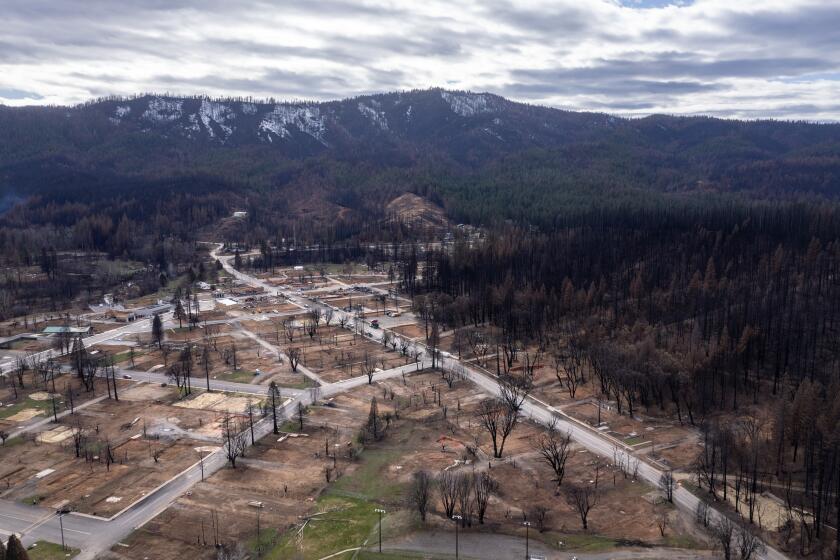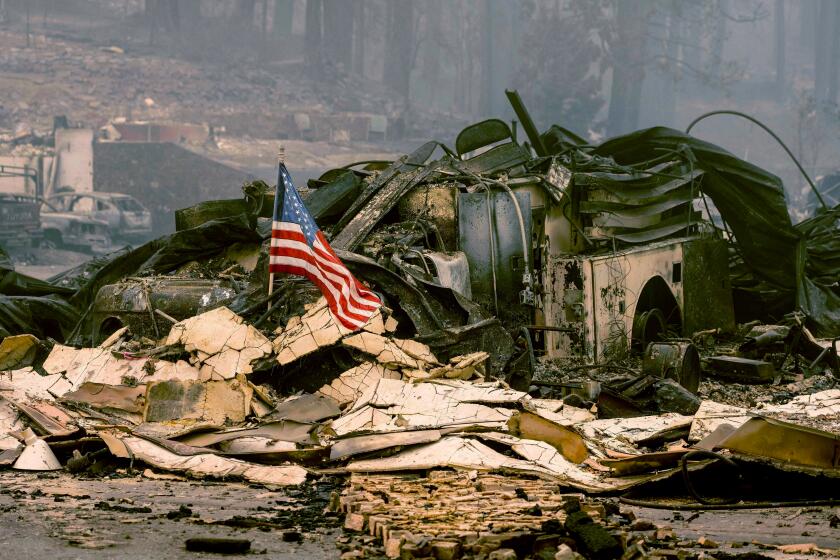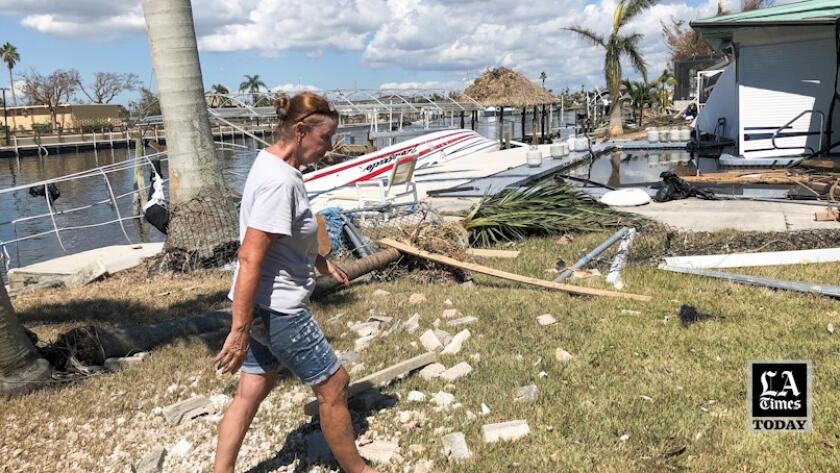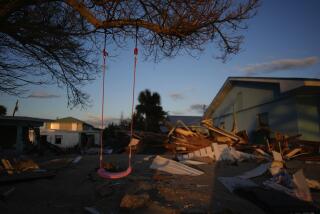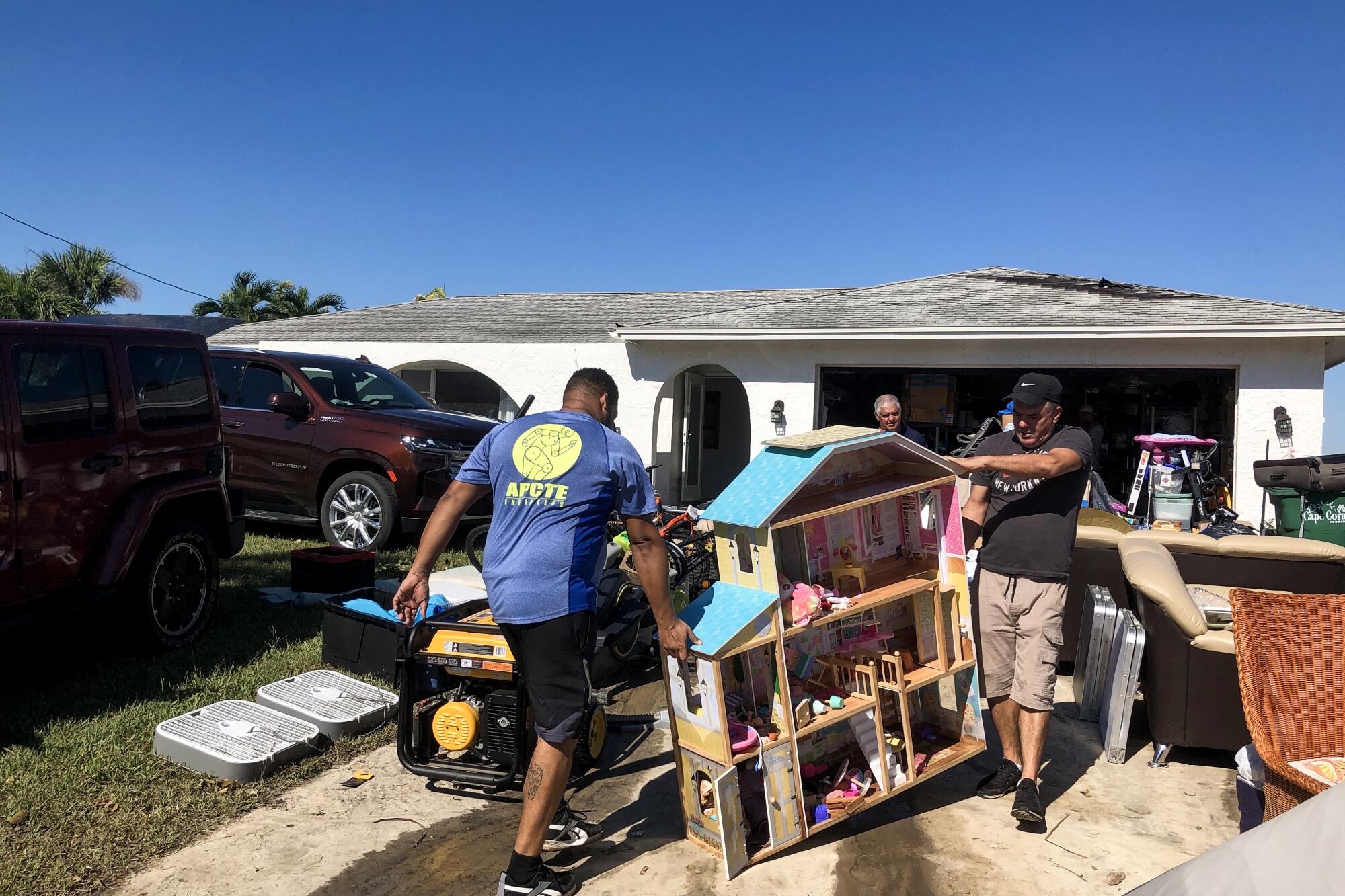
- Share via
CAPE CORAL, Fla. — A home on the water’s edge. That was the dream.
Two and a half years ago, Ignacio Soto could hardly believe his good fortune when he snagged a three-bedroom waterfront home in Cape Coral for $335,000 — a tropical haven where he could catch snapper from his dock and watch dolphins from his back patio.
But last week, after Hurricane Ian barreled into southwest Florida with a biblical surge of ocean surf, the 57-year-old registered nurse was confronting the downside of living just 7 feet above sea level.
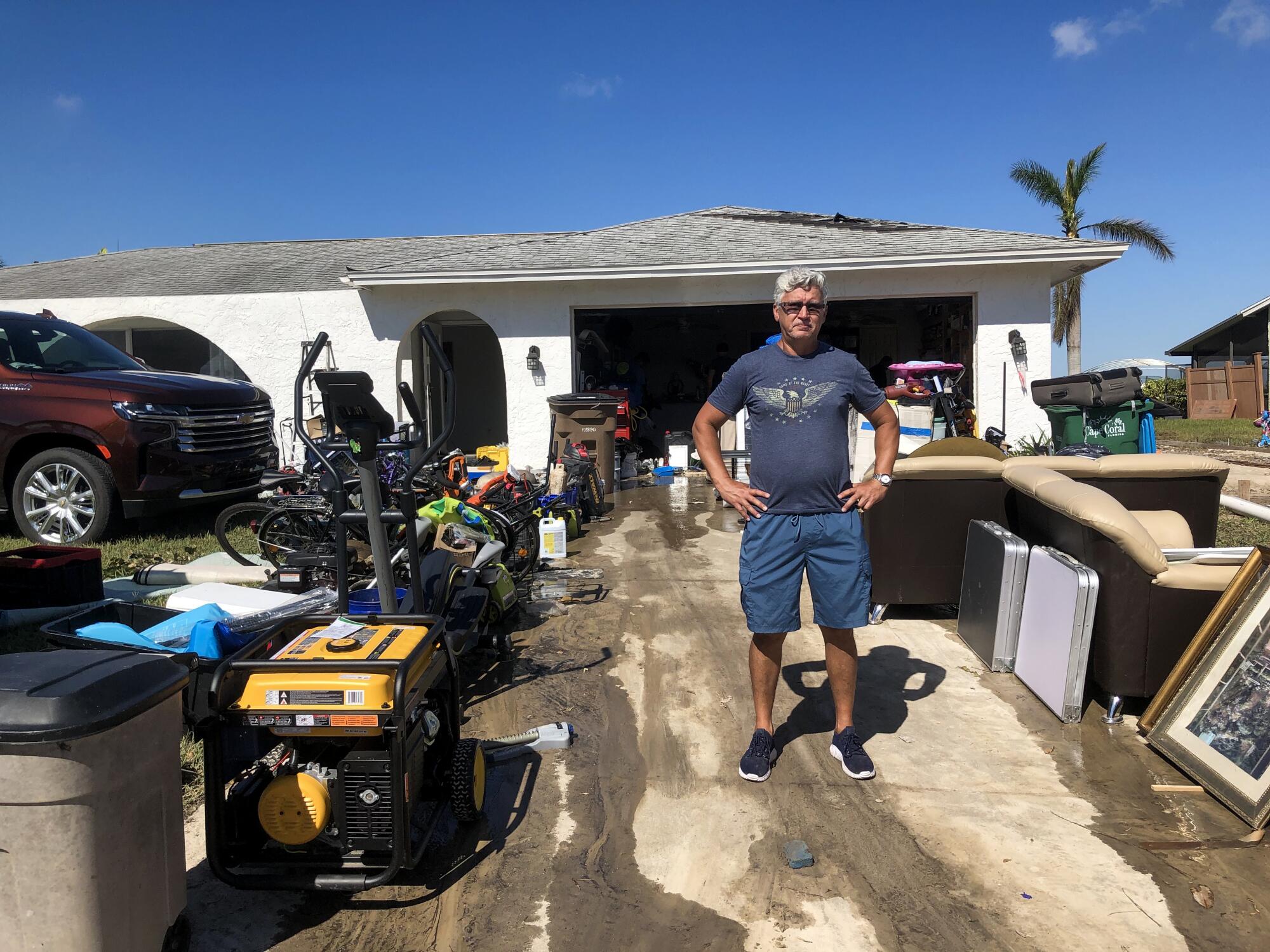
Murky brown saltwater rushed up into the Cuban immigrant’s palm-tree-dotted yard, past his wooden dock, filling his solar-heated swimming pool. It seeped into his home, soaking his laminated wood floors, kitchen cabinets and leather sofas, and reached the middle of the second story of his daughters’ wooden dollhouse.
“This has never happened before!” Soto said as he stepped through his mud-streaked living room to his patio, adding that he plans to rebuild, no matter what he recoups from insurance policies. “Look,” he said, pointing to the sparkling water beneath his tattered dock canopy, “you can’t think that the water there is gonna rise that high to come over here.”
But flooding was not unexpected. For decades, scientists, environmentalists, geographers and city planners have warned that large swaths of the U.S. coastline are at risk — and no city has a greater percentage of homes in peril than this rapidly developing Florida metropolis of 200,000 where the Caloosahatchee River empties into the Gulf of Mexico. A recent analysis of flood data found that the city has more than 90,000 properties at substantial risk of flooding, more than Los Angeles, Chicago, Houston or New York.
Five years ago, a Climate Change Vulnerability Assessment for Cape Coral warned that, in a worst-case scenario, much of the city could be underwater by 2200.
There is no question that Cape Coral will rebuild. The surge that flooded the city was widespread but not, in most cases, catastrophic enough to raze all the older 1960s- and 1970s-era homes and force homeowners to obtain permits to put up newer structures higher off the ground.
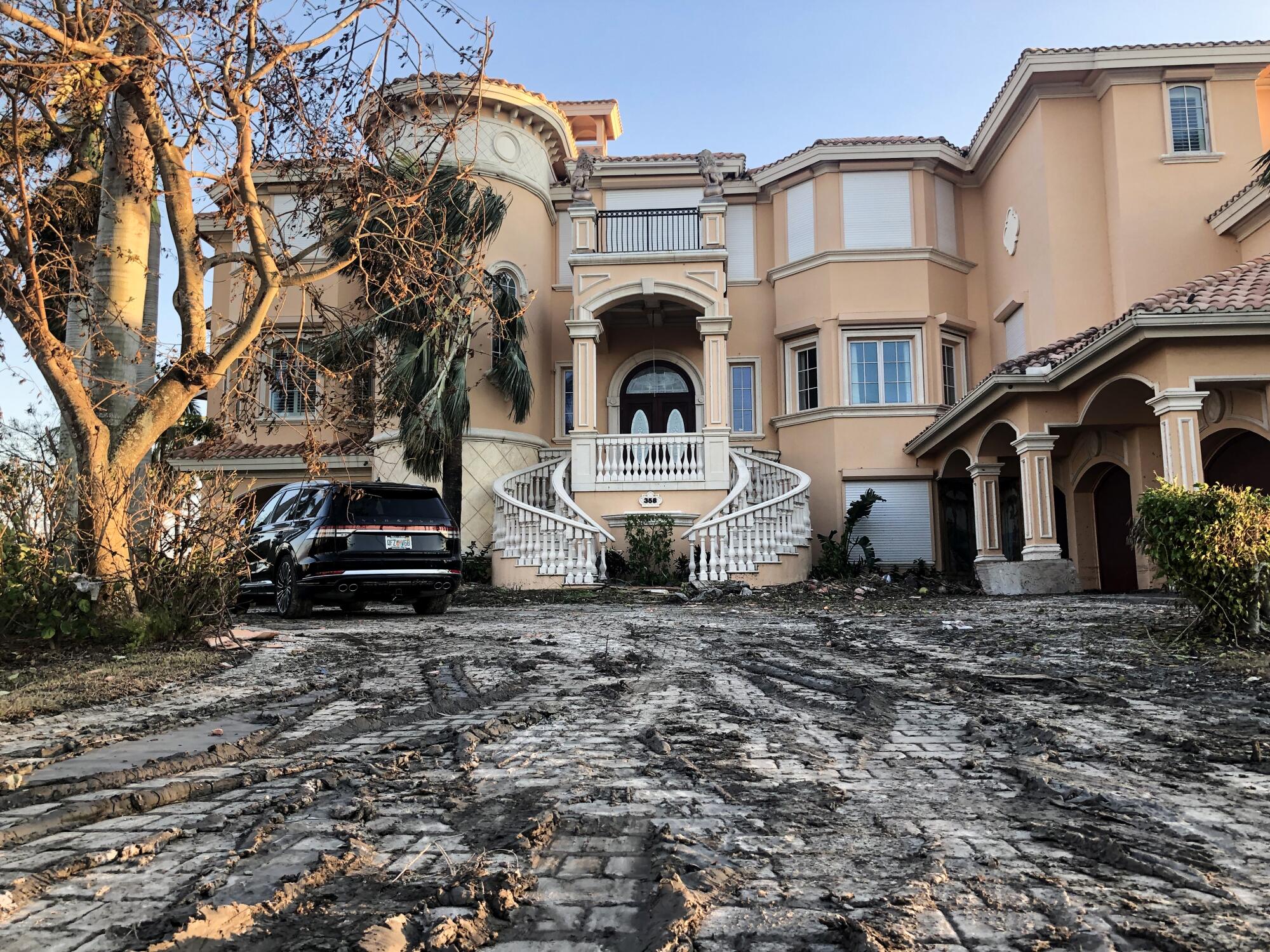
The question — for experts, at least — is whether Cape Coral and other low-lying cities should rebuild in an era of more intense hurricanes, heavier rainfall and rising seas.
“We know that Category 4 and 5 hurricanes are going to increase and storms are going to be more intense. We know the atmosphere is becoming more moist and storms are going to drop more rain,” said Benjamin Kirtman, professor of atmospheric sciences at the University of Miami. “Communities do need to think very carefully about the possibility of relocating to higher ground.”
::
Cape Coral is not the first city to risk going underwater. The sinking city of Venice has endured floods since people settled in the coastal lagoon in the 5th century as they fled barbarian conquerors. In Louisiana, New Orleans is sinking and, about 50 miles southwest, more than 98% of the tiny Isle de Jean Charles has disappeared into the Gulf of Mexico. In California, sea cliffs are crumbling and more than $150 billion in property could be at risk of flooding by 2100.
But Cape Coral’s predicament stems from a distinctly Floridian story.
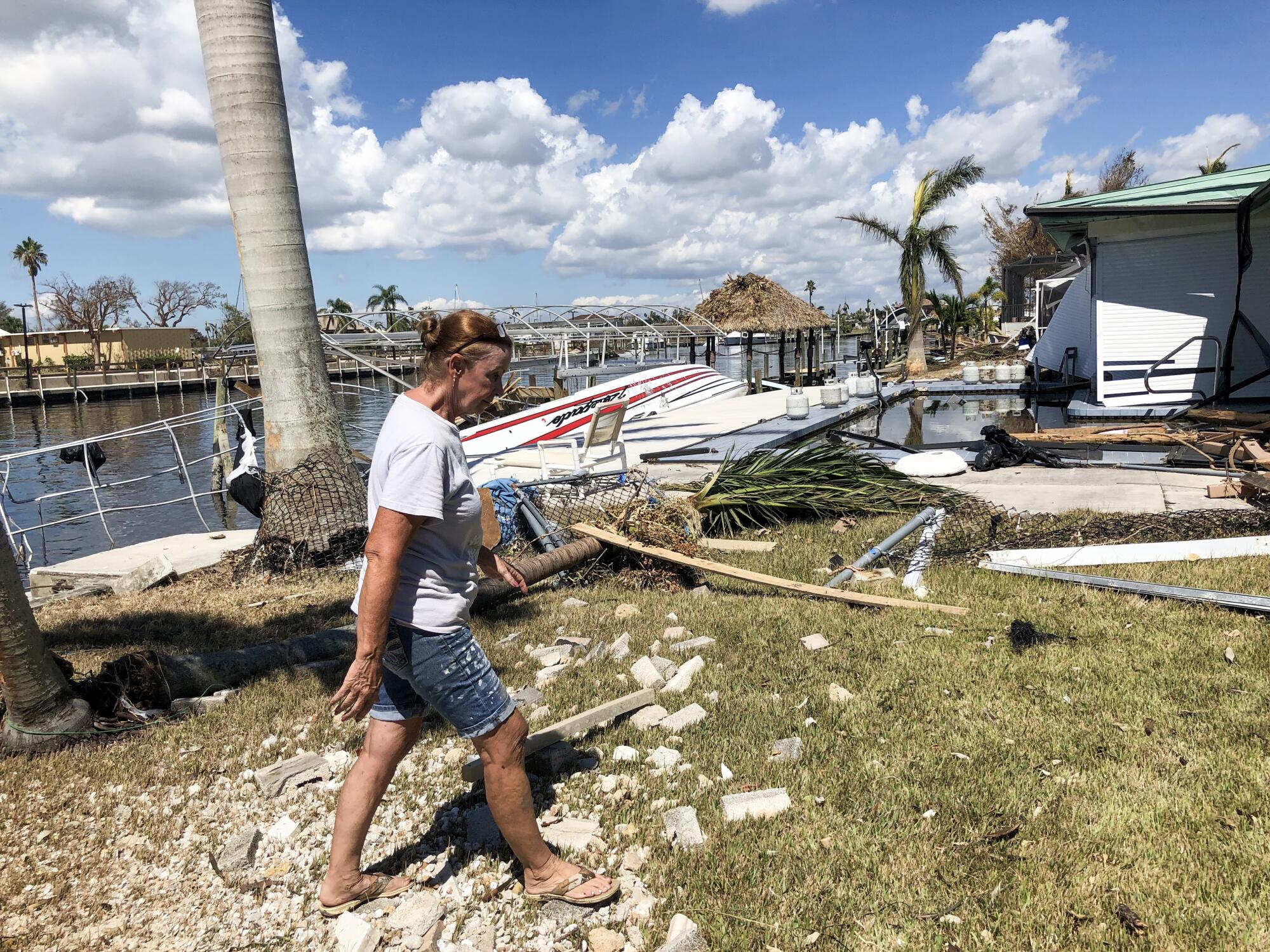
In the middle of the 20th century, this flat peninsula was a swampy, mosquito-infested spit of mangrove and palmetto scrubland inhabited by a handful of cattle ranchers.
But in 1957 a pair of marketing hucksters from Baltimore who dabbled in anti-baldness tonics bought 1,724 acres at the cape’s southwestern tip and proceeded to tear up the wetlands, dredge out nearly 400 miles of canals and carve hundreds of fingers of land into grids of quarter-acre lots.
They touted the lots as Florida’s “Waterfront Wonderland.”
“Tropic beauty” and “luxurious waterfront living,” a 1969 promotional ad pitched, “for as little as $20 down and $20 monthly.”
It sounded far-fetched, but the bet paid off. Until the 1970s, the state of Florida had no zoning or planning restrictions; only municipalities could plan and zone. Developers, in essence, would build what they wanted.
During the last half-century, Cape Coral has become a utopia for the everyman, offering blue- and white-collar retirees from the Northeast and the Midwest — and increasingly, working families and immigrants — an affordable sliver of sunny Florida on the water.
“They got Northern retirees to buy into the Florida dream for the price of cigarette money,” said Jason Vuic, a historian and author of “The Swamp Peddlers: How Lot Sellers, Land Scammers, and Retirees Built Modern Florida and Transformed the American Dream.”
The result — thousands of acres of individual lots with no downtown or commercial tax base — turned out to be an urban planning headache. It also had the makings of an environmental disaster.
“We have over 200,000 people in a place that should never really have been developed at all,” said Bill Stroud, professor emeritus of geography at Arkansas State University who has researched Cape Coral for decades.
With about 30,000 homes sitting 5 feet or less below sea level in this pancake-flat spit of land, the threat comes not just from more severe hurricanes, but from coastal erosion, declining water quality and rising seas.
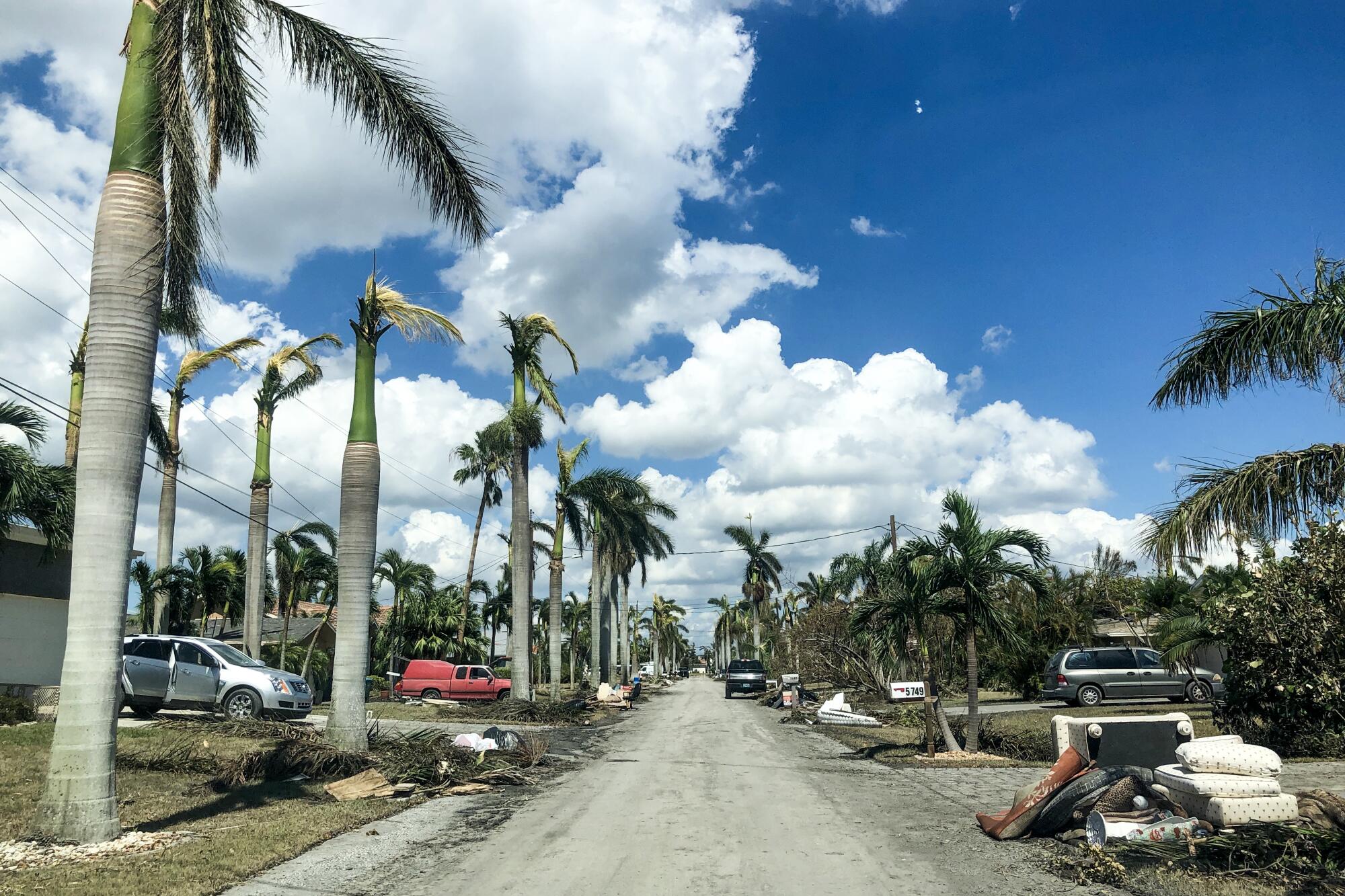
“Four hundred miles of canals on a river with rising sea levels — it’s been a selling point of Cape Coral for its entire existence, but it’s also the flaw,” Vuic said. “Cape Coral is literally straitjacketed by the sins of the grandfathers: the ‘Mad Men’ of the ’50s selling lots, never really thinking beyond Grandma and Grandpa wanting to retire.”
And people are still coming. More than 50,000 people moved to Cape Coral between 2010 and 2020. According to the Urban Land Institute, a global nonprofit research group, the city has 40,000 remaining single-family lots — and growth is happening so fast that the city could be built out in 11 years.
“If sea level rise is never going to end, we need to start considering at what point is the risk too high?” said Thomas Ruppert, a coastal planning specialist at Florida Sea Grant, a publicly funded research program that works to conserve Florida’s coast. “At what point would it make more sense to take all that effort and money and invest it someplace safer?”
Ruppert said his biggest fear was that coastal areas could turn into neighborhoods where the ultra-wealthy live on giant structures akin to oil rig platforms, relying on helicopters or boats to bring them in, leaving ordinary working people behind.
In a future ravaged by climate change, wildfires will strain resources. Bringing back every town will only put people in mortal danger once again.
::
In the days after Ian hit, this easygoing suburban paradise felt apocalyptic, turned upside down.
Fishing boats were beached on roads and cars jutted out of the water. Streets named after flamingos and pelicans were strewn with downed lines and palm trees. The power was out, the water system was shut down, urban search-and-rescue teams roamed neighborhoods, and hundreds of people lined up for ice and water.
Block after block, mounds of damp possessions piled up on the curb. On El Dorado Drive, Raphael’s cherubs peered up at the clouds from a gold framed print perched against a sodden rug. Across the street, mud-smeared beach towels hung from a storm-ravaged jacaranda tree.
Standing near the tree after erecting a tent in her frontyard, Catrin Hechl, like most residents, said she was not fazed by the flooding of her coral-colored 1970s stucco home. She would rebuild.
“This is life in Florida,” the Austrian immigrant and higher-education consultant, who moved to Cape Coral from Los Angeles in 2020, said with a shrug. “It’s all good.... I mean, you live in California long enough, you have earthquakes. In Colorado, you have blizzards.”
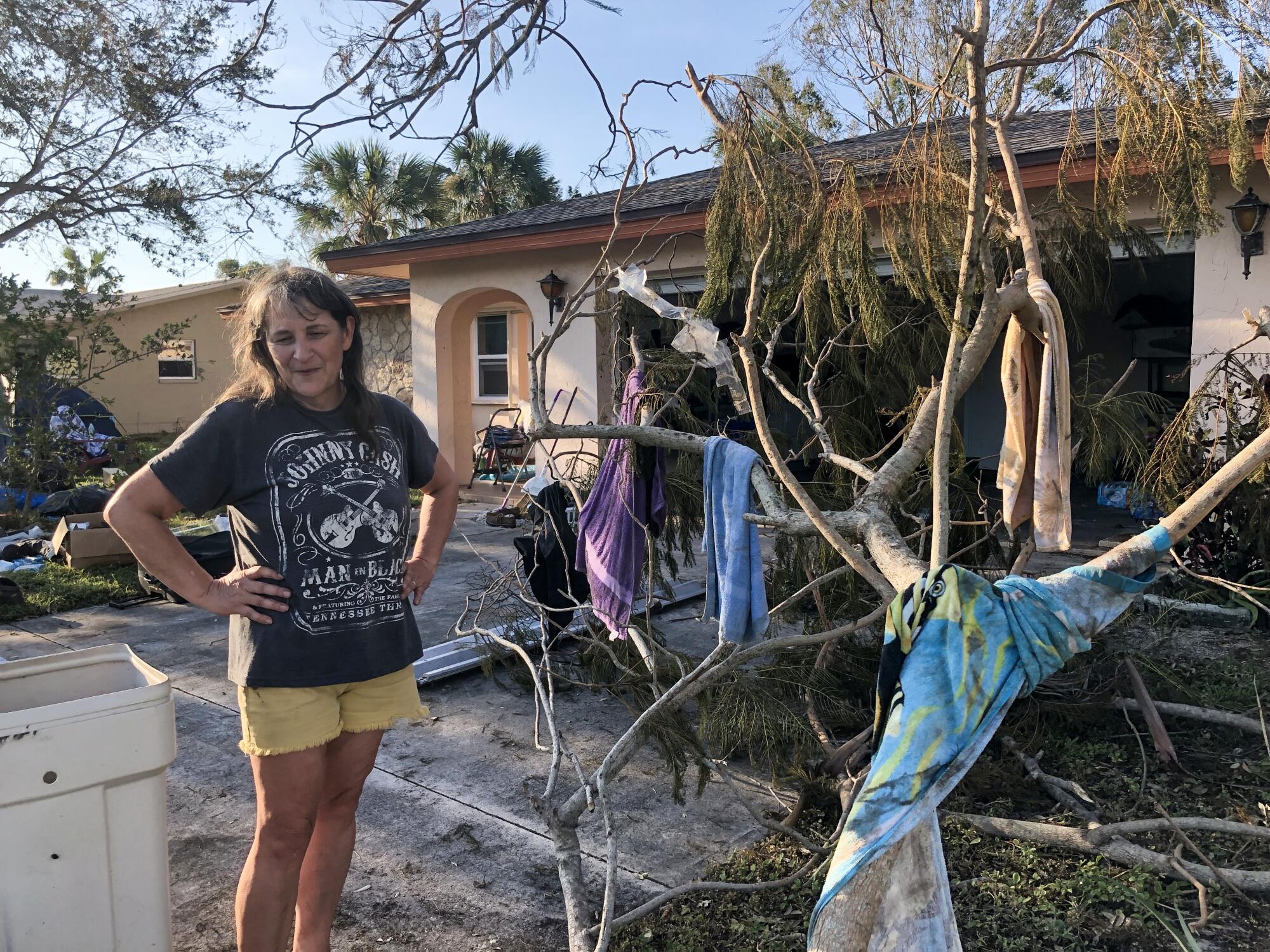
After mopping out the mud and emptying their homes of soggy furniture, some of the 58-year-old’s neighbors were already cutting out the walls to put up new sheetrock.
Hechl said she would install tiles instead of hardwood floors to better prepare for the next surge of water. Then she would keep her fingers crossed.
One day, she hoped, her 18-year-old son would inherit her home, but it was hard to consider life after another century.
“You know, we just live and we do and we buy this,” she said. “We do a lot of damage.”
::
Floridians have to follow stricter building codes developed after Hurricane Andrew slammed into south Florida in 1992, destroying more than 50,000 homes and causing about $26 billion in damage. FEMA guidelines require homeowners in areas vulnerable to flooding to build new homes higher off the ground.
But some experts say even those requirements may not be enough — and they work only up to a point.
“Yes, you can build cement fortresses 18 or 25 feet off the ground that will withstand 155-mile-an-hour winds like this,” Ruppert said. “But what about all those infrastructure services that make that house a place? What about the community around it?”
The Federal Emergency Management Agency recently changed its methodology for determining flood risk, a move that raised flood insurance payments for many Cape Coral homeowners — and prompted strong opposition from city officials.
Bill Spikowski, who lives and works in nearby Fort Myers, was a senior planner for Lee County, which includes Cape Coral, from the mid-1980s to early 1990s. The planning consultant said he finds it hard not to despair.
“There is no great solution,” he said. “If you were starting any of these communities from scratch with what we know today, we would do it very differently. But if it’s already that way, how do you retrofit it? If there were easy solutions, even hard solutions, they would be in place already.”
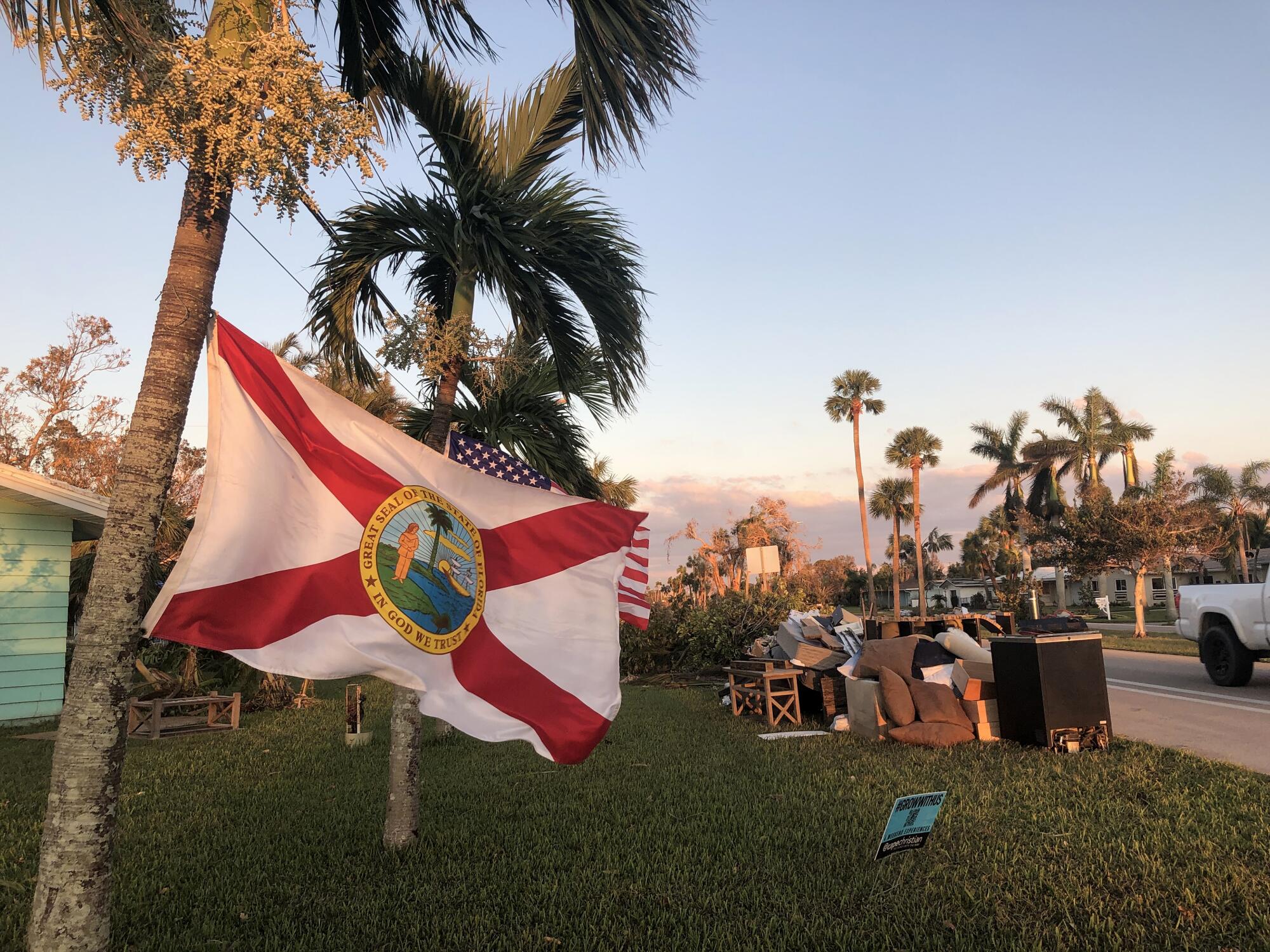
To mitigate risk, the city could require homeowners to raise new buildings even higher than the federal government requires, on pilings 15 or 25 feet above sea level. But as sea levels rise and storms get more intense, eventually roads and other infrastructure such as sewers and drains would also have to be lifted.
Another option is to follow New Orleans and build a levee or giant seawall around the city. Last year, the U.S. Army Corps of Engineers proposed building a 20-foot fortified seawall around Miami to protect six miles of downtown from flooding. But such projects cost billions and tend to be unpopular as they transform the look of the coast, undermining the area’s main draw.
Like most experts, Spikowski said the strategy of managed retreat, moving properties inland rather than seeking to hold the
line with structural engineering, was a political nonstarter.
“The dream of living near the water is strong. I’m here and so I get it. I’m one of them,” Spikowski said. “I don’t know if anybody’s willing to throw it away right now. I think it’s gonna hang on as long as it can. And then one day, if it can’t, it can’t.”
Already, homes in Cape Coral are changing. On many prime waterfront blocks, older homes are being torn down and replaced with massive, elevated two-story structures with hurricane windows. The downside is the traditional blue-collar clientele of Cape Coral cannot afford them.
Spikowski said he wouldn’t be ready to give up on the area even if he accepted that one day, low-lying spots like Cape Coral and Pine Island, where he has a second home, will not be habitable.
“Why would you say we shouldn’t enjoy it for the next 30 or 50 years?” he said. “I just can’t imagine going into a city council and telling the mayor that because it’s gonna be bad in 50 years, they should give up now.”
With climate change, California must confront hard truths on how and where we will live in the future, and what that means for decisions made today.
- Share via
Watch L.A. Times Today at 7 p.m. on Spectrum News 1 on Channel 1 or live stream on the Spectrum News App. Palos Verdes Peninsula and Orange County viewers can watch on Cox Systems on channel 99.
More to Read
Sign up for Essential California
The most important California stories and recommendations in your inbox every morning.
You may occasionally receive promotional content from the Los Angeles Times.
